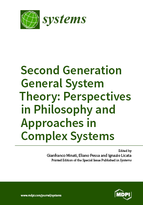Second Generation General System Theory: Perspectives in Philosophy and Approaches in Complex Systems
A special issue of Systems (ISSN 2079-8954).
Deadline for manuscript submissions: closed (31 December 2016) | Viewed by 74429
Special Issue Editors
Interests: theoretical issues on systems science; such as logical openness; collective behavior; emergence; dynamic usage of models; meta-structures; multiple-systems and collective beings; quasi-systems
Special Issues, Collections and Topics in MDPI journals
Interests: neural networks; artificial intelligence; quantum field theory; general relativity; quantum computation; general systems theory; mathematical modeling of self-organizing systems; computational neuroscience; quantum models of memory; human long-term memory; human visual perception; games theory and economic behavior
Special Issues, Collections and Topics in MDPI journals
2. School of Advanced International Studies on Applied Theoretical and Non Linear Methodologies of Physics, 70121 Bari, Italy
Interests: foundation of quantum theories; quantum cosmology; de sitter holographic models; dissipative quantum field theories; physics of emergence and organization; fisher information; sub and super turing computation models
Special Issues, Collections and Topics in MDPI journals
Special Issue Information
Dear Colleagues,
After the classical work of Norbert Wiener, Ross Ashby, Ludwig von Bertalanffy and many others, the concept of System has been elaborated in different disciplinary fields, allowing interdisciplinary approaches like in Physics, Biology, Chemistry, Cognitive Science, Economics, Education, Engineering, Social Sciences, Mathematics, Medicine, Artificial Intelligence, Philosophy, and Simulation Science.
The new challenge of Complexity and Emergence has made it even more relevant to the study of systemic aspects with high contextuality.
This conceptual shift on System concepts runs through the entire area of natural philosophy and epistemology, and requests the questioning of old and new science words in a new conceptual archipelago.
In his essay "American Lessons" (1985) the Italian writer Italo Calvino proposed six key words for the new millennium:
- Lightness
- Quickness
- Exactitude
- Visibility
- Multiplicity
- Consistency/ coherence
We think that these words, with other that the contributors will suggest, can be the basis of a possible dictionary of complexity sciences.
This special issue will focus on the nature of new problems, their eventually common aspects, properties and approaches partially already considered by different disciplines, and on new possibly unitary theoretical frameworks. In particular, this issue is devoted also to the philosophical and structural aspects of the complexity and emergence theories.
Examples of topics are: Artificial Intelligence and Simulation; Catastrophe theory; Causality and Chance in Modern Science; Chaos Theory; Cognitive Sciences; Control theory; Cybernetics; Decision theories; Dissipative Structures; Games Theory; Laws and Boundary Conditions in Complex Systems; Network Science; Probability Theories; Quantum-Like Systems; Sub- and Hyper-Computation Theories; Systems Biology.
Contributors are invited to present cases, proposals, approaches, models and theoretical frameworks to deal with such topics, for academic and disciplinary applications.
Prof. Gianfranco Minati
Prof. Eliano Pessa
Prof. Dr. Ignazio Licata
Guest Editors
Manuscript Submission Information
Manuscripts should be submitted online at www.mdpi.com by registering and logging in to this website. Once you are registered, click here to go to the submission form. Manuscripts can be submitted until the deadline. All submissions that pass pre-check are peer-reviewed. Accepted papers will be published continuously in the journal (as soon as accepted) and will be listed together on the special issue website. Research articles, review articles as well as short communications are invited. For planned papers, a title and short abstract (about 100 words) can be sent to the Editorial Office for announcement on this website.
Submitted manuscripts should not have been published previously, nor be under consideration for publication elsewhere (except conference proceedings papers). All manuscripts are thoroughly refereed through a single-blind peer-review process. A guide for authors and other relevant information for submission of manuscripts is available on the Instructions for Authors page. Systems is an international peer-reviewed open access monthly journal published by MDPI.
Please visit the Instructions for Authors page before submitting a manuscript. The Article Processing Charge (APC) for publication in this open access journal is 2400 CHF (Swiss Francs). Submitted papers should be well formatted and use good English. Authors may use MDPI's English editing service prior to publication or during author revisions.
Keywords
- Automata
- Change
- Coherence
- Computation
- Emergence
- Entanglement
- Entropy
- Forecast
- Fuzziness
- Growth
- Hypercomputation
- Incompleteness/Completeness
- Information
- Irreversibility
- Meta-structures
- Non-linearity
- Optimisation
- Planning
- Power Laws
- Predictive, Preventive, Personalized and Participatory Medicine
- Quantum-Like Systems
- Probability
- Scale invariance
- Self-organisation
- Uncertainty
- Uniqueness








